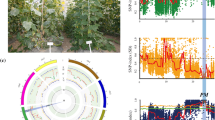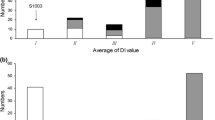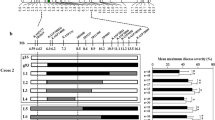Abstract
Key message
A dominantly inherited major-effect QTL for powdery mildew resistance in cucumber was fine mapped. Two tandemly arrayed cysteine-rich receptor-like protein kinase genes were identified as the most possible candidates.
Abstract
Powdery mildew (PM) is one of the most severe fungal diseases of cucumber (Cucumis sativus L.) and other cucurbit crops, but the molecular genetic mechanisms of powdery mildew resistance in cucurbits are still poorly understood. In this study, through marker-assisted backcrossing with an elite cucumber inbred line, D8 (PM susceptible), we developed a single-segment substitution line, SSSL0.7, carrying 95 kb fragment from PM resistance donor, Jin5-508, that was defined by two microsatellite markers, SSR16472 and SSR16881. A segregating population with 3600 F2 plants was developed from the SSSL0.7 × D8 mating; segregation analysis confirmed a dominantly inherited major-effect QTL, Pm1.1 in cucumber chromosome 1 underlying PM resistance in SSSL0.7. New molecular markers were developed through exploring the next generation resequenced genomes of Jin5-508 and D8. Linkage analysis and QTL mapping in a subset of the F2 plants delimited the Pm1.1 locus into a 41.1 kb region, in which eight genes were predicted. Comparative gene expression analysis revealed that two concatenated genes, Csa1M064780 and Csa1M064790 encoding the same function of a cysteine-rich receptor-like protein kinase, were the most likely candidate genes. GFP fusion protein-aided subcellular localization indicated that both candidate genes were located in the plasma membrane, but Csa1M064780 was also found in the nucleus. This is the first report of dominantly inherited PM resistance in cucumber. Results of this study will provide new insights into understanding the phenotypic and genetic mechanisms of PM resistance in cucumber. This work should also facilitate marker-assisted selection in cucumber breeding for PM resistance.





Similar content being viewed by others
References
Alfandi M, Shen L, Qi X, Xu Q, Chen X (2009) A SCAR marker linked to powdery mildew resistance for selection of the near-isogenic lines in cucumber. In: Abstracts of 4th international cucurbitaceae symposium, pp 20–21
Bourdais G, Burdiak P, Gauthier A, Nitsch L, Salojärvi J, Rayapuram C et al (2015) Large- scale phenomics identifies primary and fine-tuning roles for CRKs in responses related to oxidative stress. PLoS Genet 11:e1005373
Czernic P, Visser B, Sun W et al (1999) Characterization of an Arabidopsis thaliana receptor-like protein kinase gene activated by oxidative stress and pathogen attack. Plant J 18:321–327
de Ruiter W, Hofstede R, de Vries J, van den Heuvel H (2008) Combining QTL for resistance to CYSDV and powdery mildew in a single cucumber line. In: Pitrat M (ed) Proceedings of the 9th EUCARPIA meeting on genetics and breeding of Cucurbitaceae, INRA, Avignon, France, 21–24 May 2008, pp 181–188
El-Jack A, Munger HM (1983) Two sources conferring partial dominant resistance to powdery mildew (Sphaerotheca fuliginea Poll.) in cucumber. Cucurbit Genet Coop 6:7–8
Fujieda K, Akiya R (1962) Genetic study of powdery mildew resistance and spine color on fruit in cucumber. J Jpn Soc Hort Sci 31:30–32
Fukino N, Yoshioka Y, Sugiyama M, Sakata Y, Matsumoto S (2013) Identification and validation of powdery mildew (Podosphaera xanthii)-resistant loci in recombinant inbred lines of cucumber (Cucumis sativus L.). Mol Breed 32:267–277
He XM, Li YH, Pandey S, Yandell BS, Pathak M, Weng Y (2013) QTL mapping of powdery mildew resistance in WI 2757 cucumber (Cucumis sativus L.). Theor Appl Genet 126:2149–2161
Hofstede R, de Ruiter W, de Vries RJ, van den Heuvel H (2008) Disease resistant cucumber plants. US Patent # US 2008/0307540 A1
Huang SW, Li RQ, Zhang ZH, Li L, Gu XF, Fan W et al (2009) The genome of the cucumber, Cucumis sativus L. Nat Genet 41:1275–1281
Kinkema M, Fan W, Dong X (2000) Nuclear localization of NPR1 is required for activation of PR genes expression. Plant Cell 12:2339–2350
Kooistra E (1968) Powdery mildew resistance in cucumber. Euphytica 17:236–242
Lande R, Thompson R (1990) Efficiency of marker-assisted selection in the improvement of quantitative traits. Genetics 124:743–756
Lebeda A, Kristkova E, Sedlakova B, Coffey MD, McCreight JD (2011) Gaps and perspectives of pathotype and race determination in Golovinomyces cichoracearum and Podosphaera xanthii. Mycoscience 52:159–164
Lin XJ, Xu XW, Qian HM, Qi XH, Xu Q, Chen XH (2012) Analysis of cucumber chromosome segment introgression lines with powdery mildew resistance based on SSR markers. Acta Hort Sin 39:485–492 (in Chinese with English abstract)
Liu LZ, Yuan XJ, Cai R, Pan JS, He HL, Yuan LH, Guan Y, Zhu LH (2008) Quantitative trait loci for resistance to powdery mildew in cucumber under seedling spray inoculation and leaf disc infection. J Phytopathol 156:691–697
McKenna A, Hanna M, Banks E, Sivachenko A et al (2010) The Genome Analysis Toolkit: a MapReduce framework for analyzing next-generation DNA sequencing data. Genome Res 20:1297–1303
Morishita M, Sugiyama K, Saito T, Sakata Y (2003) Review: powdery mildew resistance in cucumber. JARQ 37:7–14
Munger HM, Morales A, Omara S (1979) Dominant genes for resistance to powdery mildew in cucumber. Cucurbit Genet Coop 2:10
Nie JT, He HL, Peng JL, Yang XQ, Bie BB, Zhao JL, Wang YL, Si LT, Pan JS, Cai R (2015) Identification and fine mapping of pm5.1: a recessive gene for powdery mildew resistance in cucumber (Cucumis sativus L.). Mol Breed 35:7
Niina I, Adrien G, Jarkko S, Riccardo S, Mikael B, Hannes K, Ari PM, Jaakko K, Michael W (2014) The Arabidopsis thaliana cysteine-rich receptor-like kinases CRK6 and CRK7 protect against apoplastic oxidative stress. Biochem Biophy Res Commun 445:457–462
Osakabe Y, Yamaguchi-Shinozaki K, Shinozaki K et al (2013) Sensing the environment: key roles of membrane-localized kinases in plant perception and response to abiotic stress. J Exp Bot 64:445–458
Perez-Garcia A, Romero D, Fernandez-Ortuno D, Lopez-Ruiz F, De Vicente A, Tores JA (2009) The powdery mildew fungus Podosphaera fusca (synonym Podosphaera xanthii), a constant threat to cucurbits. Mol Plant Pathol 10:153–160
Qi HH, Huang J, Zheng Q, Huang YQ, Shao RX, Zhu LY, Zhang ZX, Qiu FZ, Zhou GC, Zheng YL, Yue B (2013) Identification of combining ability loci for five yield-related traits in maize using a set of testcrosses with introgression lines. Theor Appl Genet 126:369–377
Rayapiram C, Michael KJ, Maiser F, Shanir JV, Hornshoj H, Rung JH, Gregersen PL, Schweizer P, Collingeb D, Lyngkjaer MF (2012) Regulation of basal resistance by a powdery mildew-induced cysteine-rich receptor-like protein kinase in barley. Mol Plant Pathol 13:135–147
Ren Y, Zhang Z, Staub J, Cheng Z, Li X, Lu J, Miao H, Kang H, Xie B, Gu X (2009) An integrated genetic and cytogenetic map of the cucumber genome. PLoS One 4:1–8
Sakata Y, Kubo N, Morishita M, Kitadani E, Sugiyama M, Hirai M (2006) QTL analysis of powdery mildew resistance in cucumber. Theor Appl Genet 112:243–250
Sambrook J, Russell DW (2001) Molecular cloning: a laboratory manual, 3rd edn. Cold Spring Harbor Laboratory, Cold Spring Harbor
Shanmugasundaram S, Williams PH, Peterson CE (1971) Inheritance of resistance to powdery mildew in cucumber. Phytopathology 61:1218–1221
Shen GJ, Zhan W, Chen HX, Xing YZ (2014) Dominance and epistasis are the main contributors to heterosis for plant height in rice. Plant Sci 215–216:11–18
Shiu SH, Bleecker AB (2003) Expansion of the receptor-like kinase/Pelle gene family and receptor-like proteins in Arabidopsis. Plant Physiol 132:530–543
Sitterly WP (1978) Powdery mildew of cucurbits. In: Spencer DM (ed) The powdery mildews. Academic Press, London, pp 359–379
Van Ooijen J, Voorrips R (2001) JoinMap 3.0, Software for calculation of genetic linkage maps. Plant Research International, Wageningen, The Netherlands
Wang SC, Basten CJ, Zeng ZB (2012) Windows QTL Cartographer 2.5. Department of Statistics, North Carolina State University, Raleigh. http://statgen.ncsu.edu/qtlcart/WQTLCart.htm. Accessed 01 Aug 2012
Wang YH, VandenLangenberg K, Wehner TC, Weng Y (2014) QTLs for downy mildew resistance and their association with LRR-RLK resistance gene analogs in cucumber. In: Proceedings of the cucurbitaceae, Bay Harbor, MI, pp 17–20
Wei XY, Wang B, Peng Q, Wei F, Mao KJ, Zhang XG, Sun P, Liu ZH, Tang JH (2015) Heterotic loci for various morphological traits of maize detected using a single segment substitution lines test-cross population. Mol Breed 35:94
Wrzaczek M, Brosché M, Salojärvi J, Kangasjärvi S, Idänheimo N et al (2010) Transcriptional regulation of the CRK/DUF26 group of receptor-like protein kinases by ozone and plant hormones in Arabidopsis. BMC Plant Biol 10:95
Zhang SP, Liu MM, Miao H, Zhang SQ, Yang YH, Xie BY, Gu XF (2011) QTL mapping of resistance genes to powdery mildew in cucumber. Sci Agric Sin 44:3584–3593
Zitter TA, Hopkins DL, Thomas CE (1996) Compendium of cucurbits diseases. APS Press, Saint Paul
Acknowledgments
This work was supported by the National Natural Science Foundation of China (No. 31171978), the National Key Basic Research Program of China (973 Program) (No. 2012CB113900), National Science & Technology Project for Rural Area (No. 2012AA100103), International Foundation for Science (No. C/5150-1) and Jiangsu Science & Technology Project (BE2012326).
Author contributions statement
X.C. and Y.W. conceived the experiment. X.X. and T.Y. performed the research. R.X., Y.S. and X.L. collected data. X.X., Y.W., Q.X. and X.Q. analyzed the data and wrote the manuscript. All authors reviewed and approved this submission.
Author information
Authors and Affiliations
Corresponding authors
Ethics declarations
Conflict of interest
The authors declare no conflict of interest.
Additional information
Communicated by M. J. Havey.
Xuewen Xu and Ting Yu have contributed equally to this work.
Electronic supplementary material
Below is the link to the electronic supplementary material.

Fig. S1
Comparison of expression level of six predicted genes in the Pm1.1 candidate gene region (Csa1M064720.1, Csa1M064730.1, Csa1M064740.1, Csa1M064750.1, Csa1M064760.1 and Csa1M064770.1). Data are the means of three replicates (±SD). The cucumber β-actin gene was used as an internal control. Each value denotes the mean relative level of expression of three replicates. Means with the same lowercase letter do not significantly differ by the least significant difference (LSD) test at p ≤ 0.05 with a completely randomized design. (JPEG 2668 kb)
Rights and permissions
About this article
Cite this article
Xu, X., Yu, T., Xu, R. et al. Fine mapping of a dominantly inherited powdery mildew resistance major-effect QTL, Pm1.1, in cucumber identifies a 41.1 kb region containing two tandemly arrayed cysteine-rich receptor-like protein kinase genes. Theor Appl Genet 129, 507–516 (2016). https://doi.org/10.1007/s00122-015-2644-4
Received:
Accepted:
Published:
Issue Date:
DOI: https://doi.org/10.1007/s00122-015-2644-4




